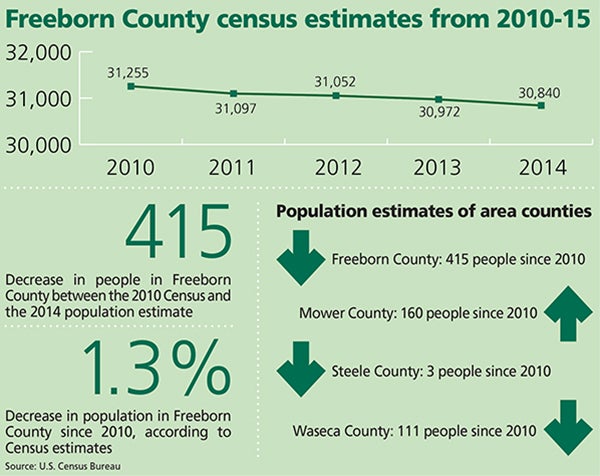Freeborn County’s census estimate down from 2010
Published 9:00 am Sunday, March 29, 2015
Freeborn County’s population has decreased over the last five years, according to 2014 estimates released this week from the U.S. Census Bureau.
In 2010, the census listed Freeborn County at 31,255 people, while in 2014, the population was estimated at 30,840 — a decline of 415 people, or 1 percent.
The estimates follow a trend of declining population seen in the decade prior.
In 2000, the census reported Freeborn County’s population at 32,584. From 2000 to 2010, the county’s population declined by 1,329 people — or 4 percent.
“I think it’s something we’ve been shown in terms of a general trend,” said Albert Lea City Manager Chad Adams. “We want to reverse that trend or slow it down and reverse it.”
Freeborn County is seeing larger declines than neighboring counties.
According to the data, Waseca County decreased by 111 people since 2010, while Steele County declined by three people.
Mower County saw an increase of 160 people since 2010, according to estimates.
Adams said he is anxiously awaiting the most recent estimated populations for Albert Lea from the state’s demographer’s office, but he estimated the city’s population declined as well. The latest estimates put the city below 18,000 people.
He said he and other community leaders realize that reversing the trend of declining population may be a challenge based on the city’s location — which is not in the metro area. Freeborn County and Albert Lea are also known for their older population.
“Our message is we have something special here in Albert Lea,” he said. “We’re unique and we want to welcome families. This can certainly be a destination for the retiring population as well.”
Albert Lea Area Schools Superintendent Mike Funk said the school district has seen a slight increase in enrollment in the last three years and is forecasting an increase through 2017.
Adams said the city is working on addressing housing needs that in turn will help attract and keep people here. Housing often tends to be tied to economic development, he said.
He noted the new St. John’s Lutheran Community on Fountain Lake will address a need for affordable senior housing, and the city is also working on bringing in market rate and workforce rental housing. He said the most recent housing study showed the city was in need of between 80 and 100 units.
“We recognize there’s a lot of job vacancies in the community, but if you don’t have the right type of housing to house those individuals, it is a much greater challenge,” he said. “Those two could complement each other — the housing and economic development.”
Adams said the city is working with the Albert Lea Economic Development Agency to create an entrepreneur program that is expected to be unveiled in the next 30 to 45 days.
“It’s not just one item that’s going to turn this around,” he said.
Census estimates around the state
Population growth in the once-booming Twin Cities suburban counties is slowing down, according to U.S. Census estimates released Thursday.
Growth in the five suburban counties collectively trails Hennepin and Ramsey counties so far this decade. Since the 1940s, those five counties have always gown at least twice as fast as the two big urban counties — home to Minneapolis and St. Paul — that they border.
But now, Ramsey County, where St. Paul is located, is growing as quickly as suburban neighbor Washington County. For half a century, Ramsey was the slowest-growing of the metro counties. In the 1990s, Washington grew eight times faster.
Anoka and Dakota counties have shown the weakest growth so far in the seven-county metro region.
Consulting demographer Tom Gillaspy said the numbers suggest that the softening of suburban growth, which began around 2005, is “not a short-run thing.”
“In 2010, people were saying, ‘When we’re fully recovered from the recession, we’ll go right back to this house-buying thing,”’ Gillaspy said. “And some of us were saying, ‘We’re not so sure.’ We’re not seeing it go back to the way it was.”
Overall, the latest estimates “continue a trend that we’ve been tracking,” said Craig Helmstetter, senior research manager for the Wilder Foundation.
“The pendulum seems to be swinging from the explosive population growth that we saw in the suburbs during the ’50s and ’60s toward more moderate growth since the turn of the century,” Helmstetter said.” We have seen a bit of a mirror image in the central cities,” where growth is accelerating.
Statewide, 46 Minnesota counties have seen population losses so far this decade, although some were minor. Drops of 3 percent or more occurred in 17 of the 87 counties.
— The Associated Press contributed to this report.






